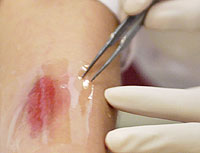Nanofibers for the healing of wounds can become a new technique to promote faster healing with less scarring. The application of these tiny fibres that consist of peptides can be manifold. The fibers can self-assemble into a mesh that can help heal areas affected by trauma. A mesh of the fibers applied to a bleeding wound can help the surgeon to stop the bleeding.The fibres can “knit” an injury,but they also can work in repairing areas of trauma in vital organs and restore tissue. Researchers have raised the possibility of application for the central nervous system too. So far the experience has come from animal experiments. Nanotechnology has been applied in animals, where the optic nerve had been severed and with the application of nanofibers the nerve could be “knitted” together and as a result the vision was restored.
The research comes from the Institute of Technology from Cambridge, Massachusetts where Rutledge Ellis-Behnke,PhD reported that healing of the nerve could be observed already within 24 hours. An incidental finding was that bleeding could be stopped when nanofibers were applied.This technique is unlike any other like cauterization. It is fast and as a result blood loss during surgery can be minimized and time needed for surgical procedures can be decreased, which translates into a faster recovery time for the patient.
Researchers are optimistic about the potential for clinical use, as the fibers are biodegradable and are excreted through the urine within 3-4 weeks or taken up by the tissue adjacent to the treatment site in the body.
Reference: JAMA. 2007;297:31 (Jan.3, 2007)
Last edited November 2, 2014






